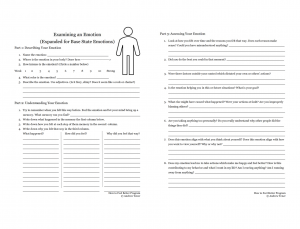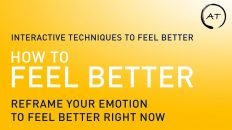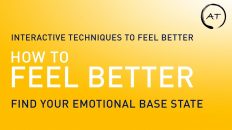Improving your emotional base state will make every moment of your life better. The fastest way to be happy and live the life you want is to improve your base state.
Generally, as problems arise in my life, I deal with them. This is great for achieving goals and addressing specific issues. But improving your base state is a much faster way to feel happier. I spend most of my emotional understanding practice on improving my base state.
During university, I was depressed. Life no longer felt worthwhile. This is when I began to improve my base state. I sought out the specific emotions that I felt all the time. These emotions were the reason I felt terrible. I then examined and released these negative emotions. If you can believe it, within about a month, I was no longer depressed. I had been doing some Cognitive Behavior Therapy (CBT) and that wasn’t making me feel better (it’s hard to do stuff when you’re depressed, and failing to do things does not make you feel any better). But when I used my own techniques to discover and release my base state, I transformed. The CBT specialist I worked with told me they had never seen anything like the transformation I had in one month.
After three months, I was happy and active again. Since then, my life has gotten better and better, and quite frankly, I consider life awesome. It’s not because I do anything crazy like heli-skiing or extravagant vacations. The reason I love my life is because my base emotions are almost all positive.
This is what I want for you. This is why I wrote a book and why I make videos. You deserve to feel great all the time. And when you feel good, you will treat other people well. Your happiness will multiply in the world, and we will all be better off.
So without further ado, let’s get to how we improve our base state. Feel free to use the worksheet I made for you here.
Examining a Base State Emotion Worksheet by Andrew Tener
- Identify some base state emotions using the Find Your Base State Exercise.
- Bring a list of base state emotions with their descriptions to your practice.
- Start with the most intense emotion on your list if you want to make the most emotional progress. If you are new or too scared, that’s totally natural. In that case, start with the least intense emotion to gain confidence.
- Find and amplify the base state emotion in your body. Let the feeling consume your whole consciousness. Give the emotion an intensity, location in your body, color, and adjective descriptors. Name the emotion.
- Continue concentrating on the emotion until a memory pops into your head. Let your mind discover the memory behind the emotion.
- Go to the memory you found. Is the feeling present in the memory? If not, return to concentrating on the emotion until another memory pops up.
- If the emotion is present in the memory, replay the memory in your head. What happened?
- Ask yourself how you felt at each point in the memory.
- Ask yourself why you felt the way you did.
- Do your reasons for your feeling make sense? Ask yourself the following questions:
- Are you misinterpreting anything? Could there be another explanation for what happened?
- Are you taking anything too personally? Do you really understand why other people did the things they did?
- Was anything your own fault? If so, that is totally fine. Did you do the best you could given what you knew at the time? If you did not, why not?
- What factors were outside of your control that dictated what happened?
- Does this feeling help you in your life? How does this emotion influence your behavior?
- Does this emotion conflict with what you want? Is the emotion helping you live how you want to live?
- Does this emotion align with what you think about yourself? Does this emotion align with how you want to view yourself? Why or why not?
- Try to understand your feeling in a new light. Look for more reasonable explanations and try to accept any true painful explanations. You should feel the intensity of the emotion lessen as you come to peace with it.
- Give the emotion a name, intensity, location in your body, color, and some adjective descriptors. How does your new description compare with your initial description?
Repeat this exercise for all the base state emotions you discover. Because base state emotions are very deep in your memory, you may become very tired after working through one or two of them. You don’t need to force yourself through practicing everything at once. Just do the amount of emotional exploration that feels right to you, provided you push yourself to open up to your emotions. I understand that intense negative emotions can be scary. Just remember that you are here now and that emotions cannot hurt you.
As you examine your base state emotions, you’ll notice a couple things:
- These emotions tend to be old and run deep in our memory. Especially as you improve your base state more and more. You need to be sure to find the earliest memory behind the emotion if you are to fully release it.
- Sometimes a base state emotion will not fully heal in one session. These emotions have become deeply intertwined with your life and may take time before you truly are ready to release them. Multiple emotions may be keeping your base emotion in place. Sometimes you must progress on other emotions before you can release an emotion.
- You might be surprised; our behavior often conflicts with the emotions we don’t want to feel. If you are normally calm, you may find repressed anger. If you are very giving, you may find lingering resentment. When you find an emotion that conflicts with your own view of yourself, you have found a very good emotion to work through. The emotions we try to cover up are hindering our growth as people.
- Some parts of your base state can be felt, but you cannot discover the emotion behind the feeling. This is totally fine. Accept it. One day, you will be able to understand what the feeling is, you just need to make more progress on your emotional journey.
Working through base emotions can be tricky, but the happiness and extra energy you will receive make it so worth it!
Cheers!
Andrew


